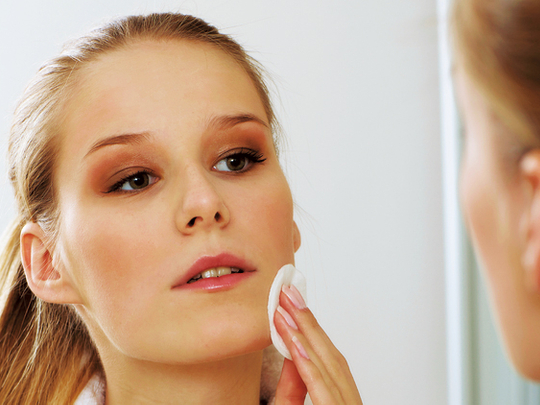
It's strange that despite the Three-phase CTM routine of cleansing, toning and moisturising reiterated by skincare experts time and again, one of the products that is invariably absent from many women's vanity kits is a toner. In fact many women consider it to be an unnecessary extra step. But contrary to all such notions, the use of the right toner (based on your skin type) can help you maintain a healthy, vibrant and clear skin.
A toner is among the most basic steps of daily skincare. Although most of us don't realise it, toning is actually an advanced step in skin cleansing. A toner helps to clarify the skin's pores, and refresh and soothe the skin.
Mamta Thakkar, Merle Norman's UAE GM gives a lowdown on these skin-friendly lotions.
What is the main purpose of a facial toner?
Toners are used after cleansing and help to balance, condition and soothe the skin. They remove residue that is invisible to the naked eye and prepare the skin to draw in the benefits of a moisturiser. Some toners also possess hydrating and exfoliating properties.
What are the differences between a toner and a refreshing face mist/spritzer (sprayed over make-up to refresh face at midday)?
Toners should be on the "must-have" list, while spritzers can be placed on the "nice-to-have" list in skincare routine.
Toners are often confused by many women with refreshing face mists/spritzers, which are sprayed over make-up to refresh at midday. The latter are very different. They offer a cooling, refreshing and energising feeling to the skin but have no cleansing or pore-reducing properties. Some spritzer formulations are also packed with antioxidants and vitamins and sometimes help to fix the make-up as well.
What skin types should use a toner?
Toners are an important step in a skincare programme for any skin type - cleanse, tone and moisturise.
What are the various kinds of toners today?
A calming toner, as the name suggests calms red, blotchy skin, which is prone to flare-ups.
A rejuvenating one revives and invigorates dull-looking skin, while maintaining a smooth, supple skin texture.
The anti-acne version is ideal for skin that is prone to breakouts and the formulations are designed to control excess oil on the skin's surface, which clogs open pores, thus resulting in acne.
A whitening toner helps brighten, exfoliate and smoothen the appearance of sun-damaged skin.
A cleansing toner is designed to deep-clean the pores and immediately reduce shine - ideal for oily skin.
A toner meant for sensitive skin is packed with soothing ingredients, designed for customers with delicate skin conditions. These are usually fragrance-free with no exfoliating benefits, since both exfoliation and fragrance may irritate sensitive skin.
So toning is as essential as cleansing and moisturising?
Yes. If you consistently miss this crucial step, you could create a build-up of grime and grease leading to dull skin.
Why do most toners contain alcohol? Can too much alcohol dry out the skin and cause acne?
Alcohol does have a drying effect on the skin, but it is the overall composition of the toner that determines its ultimate effectiveness. Newer, advanced formulations for different skin types are developed to address different skin concerns like, calming toners for dry skin, soothing toners for sensitive skin, AHA toners for normal to dry, normal to oily skins, and clarifying for oily skins.
What is the ideal sequence of toning?
No matter what your skin type, follow this programme: cleanse, tone and moisturise every morning and evening, which means twice a day. Cleanse to remove make-up, dirt, grime and other impurities without stripping away the skin's essential moisture. Tone to remove excess cleanser and the residual impurities left after cleansing. This is a good way to prepare your skin for moisturising.
Is it important to buy a toner of the same brand as your cleanser and moisturiser?
Shop for a toner with great care because the wrong one can leave you with problematic skin. For example, if you have dry skin and you buy a toner meant for oily skin, you could end up excessively dry skin as the toner will strip it of excess grease. A toner in many ways helps maximise the benefits of a total skincare regime. When it comes to brand similarity, it is ideal to opt for a cleanser, toner and moisturiser from the same brand. Also get a skin assessment test done to determine your skin type. Insist on a demonstration and trial of the product to immediately know whether it works for your skin or not.
How much toner should be used?
It's best to just dampen the cotton pad with the toner. That's because a saturated pad would lead to product wastage and the extra drops would end up trickling down your neck which is a messy feeling. Using less to begin with always allows you to add a few more drops to a fresh pad rather than deal with the excess.
How long should one wait after toning to apply a moisturiser?
Many toners evaporate very quickly but others take a bit longer. In my opinion, it's best to apply the moisturiser while your face is still slightly damp from the toner as this helps spread it better. Otherwise you'd have to use a little more moisturiser.
Is it alright to store toners in the refrigerator? What is the shelf life of a toner?
Most toners are meant to stay in perfect condition at room temperature - keeping them in the refrigerator is a personal preference. For instance, I have irritable skin, so I like the way a "chilled" toner soothes my skin. If you use a toner everyday, it would last you for about three months. Although toners have a shelf life of three years if unopened, it's not recommended to use them beyond six months after opening.
Is it wise to buy more than one brand of toner to use alternately?
There is no need to combine two toners and anybody who tells you otherwise is just trying to make money.
Three ways to apply your toner
- One of the best ways of applying a toner is to spritz it on a piece of damp cotton wool and then rub it over the skin, especially the greasy T-zone. If one piece isn't enough for the entire face, take a few more and tone the remaining parts of the face. This is the recommended application method for toning at the end of the day since it helps remove the invisible grime most effectively.
- Many women also prefer spraying the toner directly on to the face using a vaporiser. Nowadays a lot of brands also bottle their toners in spritzer bottles. This method feels quite refreshing but the toner usually needs more drying time in this case. The method works best in the mornings when you don't have too much grime sticking on to the facial skin anyway.
- Yet another method of applying a toner that's used by some spas and salons during facials is to use a gauze facial mask. A piece of gauze is covered with toner and left on the face for a few minutes. It is important to allow the toner to dry up before applying the moisturiser.
Tone up
Different skin types require different kinds of toners. We’ve got you covered – be it over-the-counter versions or a home-made toner just like your grandma recommended.
Dry skin
Over-the-counter toner for dry skin: Merle Norman Luxiva Daily Moisture Toner, Dh84
Kitchen ingredient for dry skin toner:
- 1 medium cucumber, peeled, roughly chopped
- 2 tbsp dark, organic honey
Preparation:
- Prep time: Three hours (includes refrigeration time)
- Method: Blend the cucumber in a food processor. Strain the pulp through a sieve and reserve the juice in a glass bottle. Add dark organic honey to the juice, secure cap and shake vigorously to blend. Refrigerate for 2-3 hours and then use daily, applying it with damp cotton wool. Rinse off before applying a moisturiser.
- Storage: Lasts for two weeks
Combination skin
Over-the-counter toner for combination skin: The Body Shop Seaweed Clarifying Toner, Dh42
Kitchen ingredient for combination skin toner:
- 4 tbsp rose water
- 1/2 tbsp alum
- 100g glycerine
Preparation:
- Prep time: Four days (includes refrigeration time)
- Method: In a bowl, mix together rose water, alum and glycerine and transfer to a clean glass bottle after mixing well. Refrigerate for 3-4 days, shake well and it’s ready to apply. Apply with a damp cotton pad. Rinse off after 15 minutes if you like as it can leave you with a slightly sticky feeling.
- Storage: Lasts for Three weeks
Oily skin
Over-the-counter toner for oily skin: Kiehl’s Ultra Facial Oil-Free Toner, Dh59
Kitchen ingredient for oily skin toner:
- 1 cup dried lavender flowers
- 2 cups fresh lavender
- 2 cups of boiling water
- 1 tbsp apple cider vinegar
Preparation:
- Prep time: Five to six hours (includes cooling and refrigeration time)
- Method: Place the dried lavender flowers in a large glass bowl, then pour hot water over. Allow infusion to cool, then strain. Add apple cider vinegar to the floral infusion. Refrigerate and apply with a cotton pad. Allow the skin to air dry.
- Storage: Lasts for 3 weeks
Toner recipes by Mamta Thakkar, Merle Norman’s UAE GM











